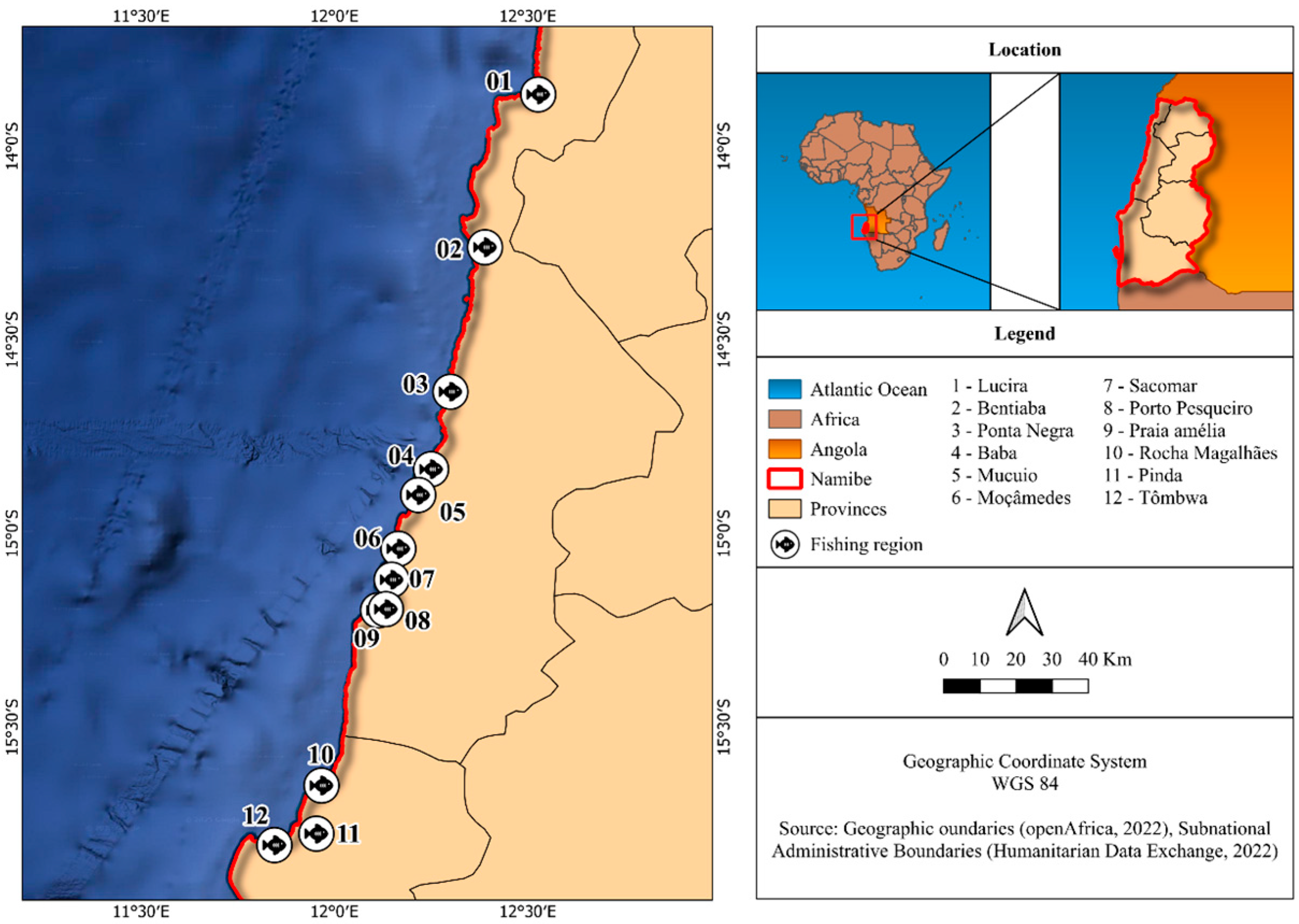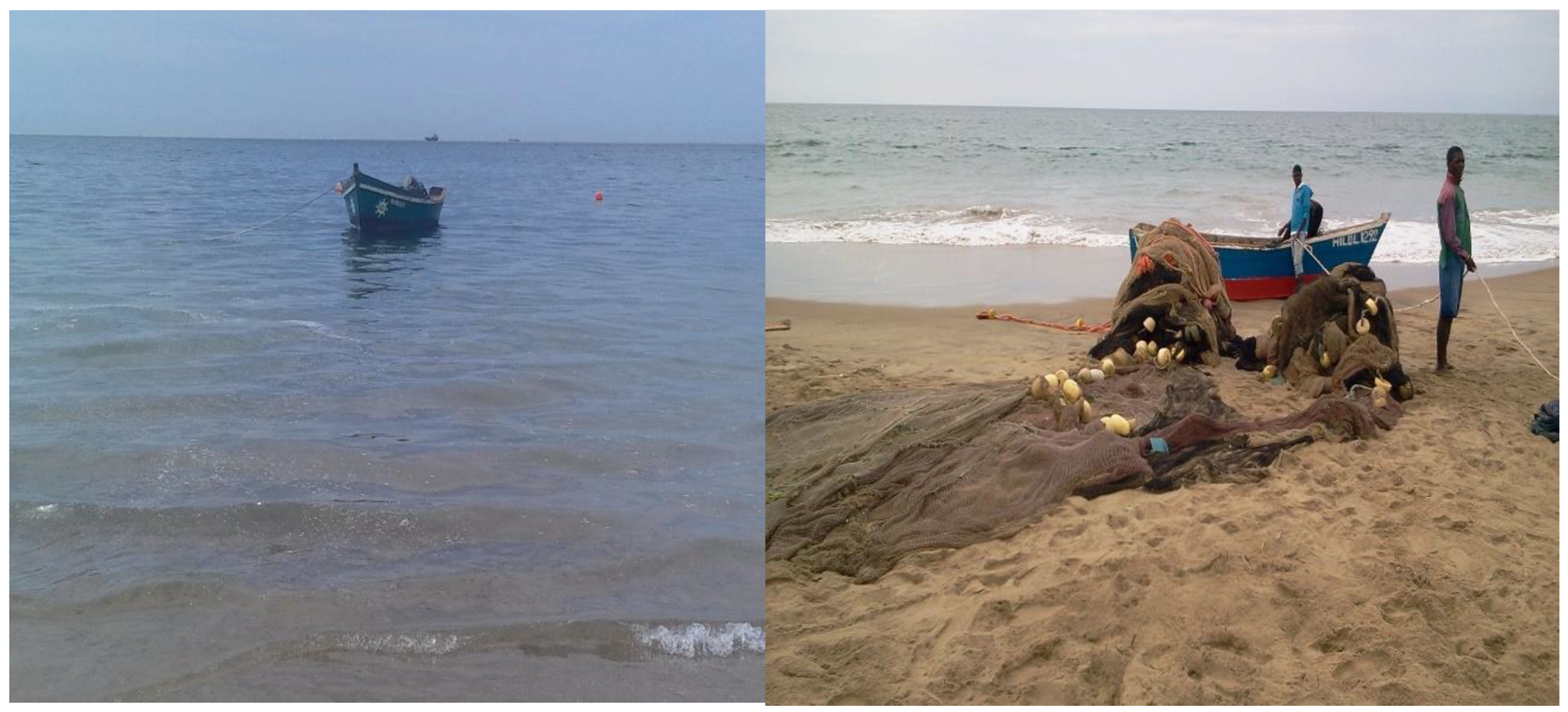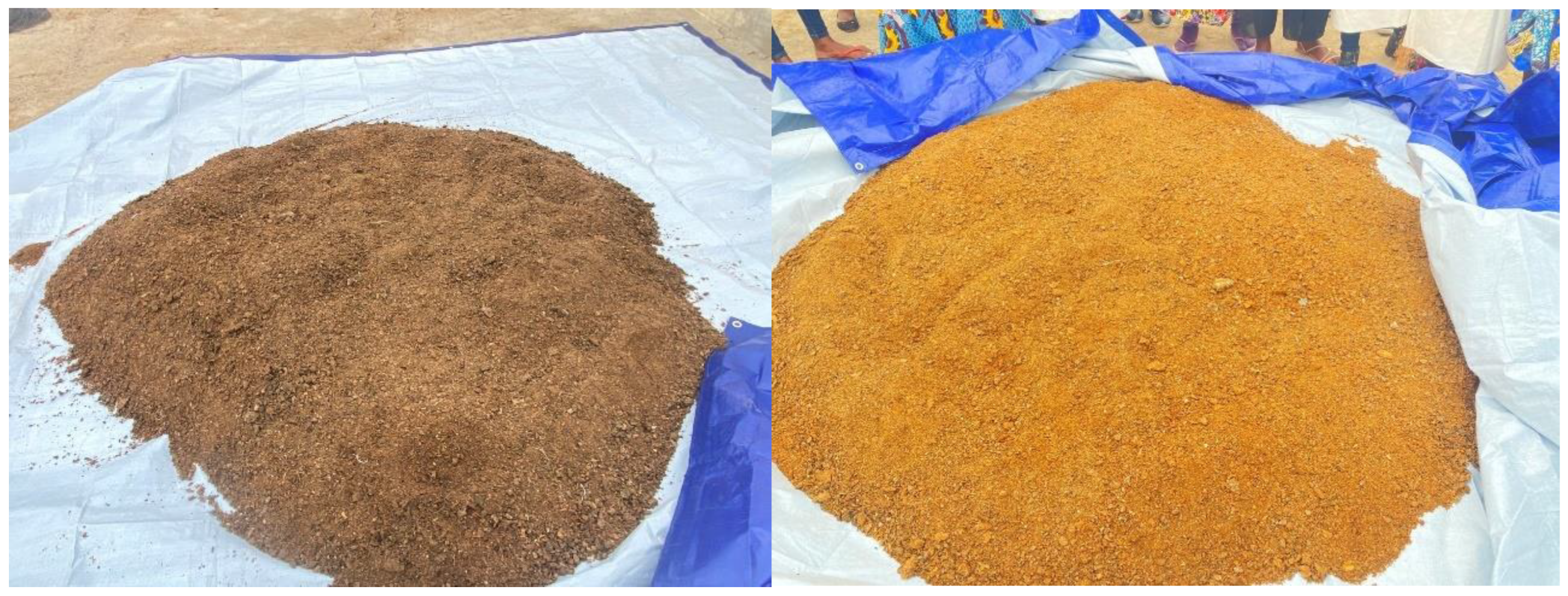Dried Fish and Fishmeal as Commodities: Boosting Profitability for Artisanal Fishers in Namibe, Angola
Abstract
1. Introduction
2. Materials and Methods
2.1. Study Area
2.2. Characterization of the Small-Scale Fleet and Estimation of Fishery Production
2.3. Economic Viability Analysis of Artisanal Fisheries
2.3.1. Estimation of Production Costs
- (a)
- Effective Operating Cost (EOC): includes expenses directly related to fishing activity, such as fuel, engine oil, vessel and gear maintenance, and labor (fisher and assistant) compensation;
- (b)
- Total Operating Cost (TOC): comprises the EOC plus financial charges, estimated as an annual interest rate applied to 50% of the EOC value, as well as depreciation of the vessel, engine, and fishing gear;
- (c)
- Total Production Cost (TPC): includes the TOC plus annual interest for the capital initially invested in the activity.
2.3.2. Investment Return and Profitability Indicators
- (a)
- Gross Revenue (GR): product of production volume and average selling price per kilogram of fish;
- (b)
- Operating Profit (OP): difference between GR and TOC, i.e., OP = GR − TOC;
- (c)
- Gross Margin (GM): expresses profitability relative to TOC, calculated as GM = (GR − TOC)/TOC) × 100;
- (d)
- Profitability Index (PI): percentage of operating profit in relation to GR, calculated as PI = (OP/GR) × 100.
2.4. Sensitivity Analysis
3. Results
3.1. Characteristics of the Fishing Activity
Vessel Typology and Fishing Gear Used
3.2. Economic Viability of Artisanal Fishing
4. Discussion
5. Conclusions
Author Contributions
Funding
Institutional Review Board Statement
Informed Consent Statement
Data Availability Statement
Conflicts of Interest
References
- FAO. The State of World Fisheries and Aquaculture 2024: Blue Transformation in Action; FAO: Rome, Italy, 2024. [Google Scholar] [CrossRef]
- Hanamulamba, P.L.; Medeiros, T.V.; Lourenço, I.H.; Dos Anjos, M.R.; Duarte, L.F.A. The small-scale fisheries sector in a developing country: Assessing SWOT and recommendations for sustainability in Namibe (Angola). Fish. Sci. 2025, 91, 1–11. [Google Scholar] [CrossRef]
- Kirkman, S.P.; Nsingi, K.K. Marine biodiversity of Angola: Biogeography and conservation. In Biodiversity of Angola; Huntley, B., Russo, V., Lages, F., Ferrand, N., Eds.; Springer: Cham, Switzerland, 2019; pp. 41–58. [Google Scholar] [CrossRef]
- Albino, L.E. A Economia Do Mar e o Impacto da Pesca Industrial em África (PALOP) Versus Pesca Artesanal em Angola; ISCTE—Instituto Universitário de Lisboa: Lisboa, Portugal, 2024; Available online: https://www.proquest.com/openview/7ef020b9cd9b995734307e3e60983ff7/1?pq-origsite=gscholar&cbl=2026366&diss=y (accessed on 10 July 2025).
- EU–Angola Dialogues. Diagnóstico Sectorial Do Sector da Pesca em Angola, Com Enfoque na Pesca Artesanal e de Pequena Escala. 2023. Available online: https://dialogosue-angola.org/acoes/diagnostico-sectorial-do-sector-da-pesca-em-angola-com-enfoque-na-pesca-artesanal-e-de-pequena-escala/ (accessed on 23 June 2025).
- Basurto, X.; Gutierrez, N.L.; Franz, N.; Smith, H.; Cohen, P.J.; Allison, E.H. Illuminating the multidimensional contributions of small-scale fisheries. Nature 2025, 637, 875–884. [Google Scholar] [CrossRef]
- Hilborn, R.; Ovando, D. Reflections on the success of traditional fisheries management. ICES J. Mar. Sci. 2014, 71, 1040–1046. [Google Scholar] [CrossRef]
- Chuenpagdee, R.; Jentoft, S. Transforming the governance of small-scale fisheries. Marit. Stud. 2018, 17, 101–115. [Google Scholar] [CrossRef]
- World Bank. Blue Economy Development Framework: Toward a Sustainable Ocean Economy in Africa; World Bank: Washington, DC, USA, 2020; Available online: http://hdl.handle.net/10986/42988 (accessed on 15 May 2025).
- Béné, C.; Barange, M.; Subasinghe, R.; Pinstrup-Andersen, P.; Merino, G.; Hemre, G.I.; Williams, M. Feeding 9 billion by 2050—Putting fish back on the menu. Food Secur. 2016, 7, 261–274. [Google Scholar] [CrossRef]
- Zugarramurdi, M.A.; Parin, G.A.; Carrizo, L.; Gadaleta, G.; Lupin, H.M. Investment and production costs for fishmeal plants in developing and developed countries. Int. J. Prod. Econ. 2002, 76, 53–59. [Google Scholar] [CrossRef]
- Fréon, P.; Durand, H.; Avadí, A.; Huaranca, S.; Moreyra, R.O. Life cycle assessment of three Peruvian fishmeal plants: Toward a cleaner production. J. Clean. Prod. 2017, 145, 50–63. [Google Scholar] [CrossRef]
- Mustapha, M.K.; Ajibola, T.B.; Salako, A.F.; Ademola, S.K. Solar drying and organoleptic characteristics of two tropical A frican fish species using improved low-cost solar driers. Food Sci. Nutr. 2014, 2, 244–250. [Google Scholar] [CrossRef] [PubMed]
- Tacon, A.G.J.; Metian, M. Feed matters: Satisfying the feed demand of aquaculture. Rev. Fish. Sci. Aquac. 2015, 23, 1–10. [Google Scholar] [CrossRef]
- SADC. Blue Economy Strategy for Southern Africa; Southern African Development Community: Gaborone, Botswana, 2021; Available online: https://www.sadc.int/latest-news/sadc-has-potential-develop-fisheries-and-blue-economy-businesses-new-heights-sadc (accessed on 20 June 2025).
- Potts, W.M.; Inácio, L.A.; Santos, C.V.; Richardson, T.J.; Sauer, W.H.H. Aspects of the biology and fisheries of Dentex macrophthalmus in the Namibe province, Angola. Afr. J. Mar. Sci. 2010, 32, 601–611. [Google Scholar] [CrossRef]
- Gindre-Chanu, L.; Warren, J.K.; Puigdefabregas, C.; Sharp, I.R.; Peacock, D.C.P.; Swart, R.; Poulsen, R.; Ferreira, H.; Henrique, L. Diagenetic evolution of Aptian evaporites in the Namibe Basin (south-west Angola). Sedimentology 2015, 62, 204–233. [Google Scholar] [CrossRef]
- Parker, C.; Scott, S.; Geddes, A. Snowball sampling. SAGE Res. Methods 2019, 1, 1–121. [Google Scholar] [CrossRef]
- Souza, K.M.; Casarini, L.M.; Henriques, M.B.; Arfelli, C.A.; Lopes, R.G. Viabilidade econômica da pesca de camarão-sete-barbas com embarcação de pequeno porte na praia do Perequê, Guarujá, SP. Inf. Econ. 2009, 39, 30–37. [Google Scholar]
- Da Silva, S.M.; Amorim, A.F.; Castilho-Barros, L.; Silva, N.J.R.; Henriques, M.B. How the commercialization of live bait impacts the profitability of artisanal fishing in a Brazilian estuary: A proximity economy approach. Reg. Stud. Mar. Sci. 2025, 83, 104057. [Google Scholar] [CrossRef]
- Engle, C.R.; Pomerleau, S.; Fornshell, G.; Hinshaw, J.M.; Sloan, D.; Thompson, S. The economic impact of proposed effluent treatment options for production of trout Oncorhynchus mykiss in flow-through systems. Aquac. Eng. 2005, 32, 303–323. [Google Scholar] [CrossRef]
- Ehrlinch, P.J.; Moraes, E.A. Engenharia Econômica: Avaliação e Seleção de Projetos de Investimento; Atlas: São Paulo, Brazil, 2005; p. 186. [Google Scholar]
- Henriques, M.B.; Castilho-Barros, L.; Souza, M.R.; Barbieri, E.; Silva, N.J.R.; Nunes, F.A.A.; Sanches, E.G. Is the small-scale aquaculture of Deuterodon iguape for live bait in recirculating systems economically profitable? Aquaculture 2021, 546, 737335. [Google Scholar] [CrossRef]
- Martin, N.B.; Serra, R.; Oliveira, M.D.M.; Angelo, J.A.; Okawa, H. Sistema integrado de custos agropecuários—CUSTAGRI. Inf. Econ. 1998, 28, 7–28. [Google Scholar]
- Phillipson, J.; Salmi, P.; Linke, S.; Svels, K.; Budzich-Tabor, U. Fisheries local action groups, small-scale fisheries and territorial development. Sociol. Ruralis. 2024, 64, 399–414. [Google Scholar] [CrossRef]
- FAO. Nova Fase do Projeto de Pesca Artesanal e Aquicultura Lançada para Aumentar a Segurança Alimentar em Angola. 2025. Available online: https://www.fao.org/angola/news/detail/new-phase-of-the-artisanal-fishing-and-aquaculture-project-launched-to-enhance-food-security-in-angola/pt (accessed on 19 June 2025).
- Sossae, F.C. Mulheres na atividade pesqueira: Um estudo na comunidade de Nzeto-Angola. Rev. Bras. Multidiscip. 2020, 23, 68–85. [Google Scholar] [CrossRef]
- OECD. The New Rural Paradigm: Policies and Governance; Organisation for Economic Co-Operation and Development (OECD): Paris, France, 2016. [Google Scholar] [CrossRef]
- UNDP. Human Development Report 2021–2022: Uncertain Times, Unsettled Lives; UNDP: New York, NY, USA, 2022; Available online: https://hdr.undp.org/content/human-development-report-2021-22 (accessed on 30 June 2025).
- Torre, A.; Wallet, F. Regional Development and Proximity Relations; Edward Elgar Publishing: Cheltenham, UK, 2014; 392p. [Google Scholar]
- Kolding, J.; Béné, C.; Bavinck, M. Small-scale fisheries: Importance, vulnerability and deficient knowledge. In Governance of Marine Fisheries and Biodiversity Conservation: Interaction and Coevolution; Wiley: Hoboken, NJ, USA, 2014; Volume 1, pp. 317–331. [Google Scholar] [CrossRef]






| Fishing Resource | Scenario A (Pessimistic) | Scenario B (Baseline Conditions) | Scenario C (Optimistic) | |||
|---|---|---|---|---|---|---|
| kg/Week | USD 1 | kg/Week | USD 1 | kg/Week | USD 1 | |
| Scomber japonicus | 162 | 174.15 | 180 | 193.50 | 198 | 212.85 |
| Spondyliosoma cantharus | 27 | 30.96 | 30 | 34.40 | 33 | 37.84 |
| Pomatomus saltatrix | 9 | 43.54 | 10 | 48.37 | 11 | 53.21 |
| Pseudotolithus typus | 9 | 52.24 | 10 | 58.05 | 11 | 63.85 |
| Dentex macrophthalmus | 216 | 325.08 | 240 | 361.20 | 264 | 397.32 |
| Pagellus bellottii | 54 | 48.37 | 60 | 53.75 | 66 | 59.12 |
| Epinephelus aeneus | 14 | 79.82 | 15 | 88.69 | 17 | 97.56 |
| Total/week | 491 | 754.16 | 545 | 865.68 | 600 | 952.25 |
| Total/month | 1962 | 3016.64 | 2180 | 3351.82 | 2398 | 3687.01 |
| Total/year | 23,544 | 36,199.69 | 26,160 | 40,222.88 | 28,776 | 44,244.07 |
| 100–0% 1 | 90–10% | 80–20% | 70–30% | 60–40% | 50–50% | |||||||
|---|---|---|---|---|---|---|---|---|---|---|---|---|
| kg/Week | USD | kg/Week | USD | kg/Week | USD | kg/Week | USD | kg/Week | USD | kg/Week | USD | |
| Scomber japonicus (Consumption) | 180 | 193.50 | 162 | 174.15 | 144 | 154.80 | 126 | 135.45 | 108 | 116.10 | 90 | 96.75 |
| S. japonicus (Processed) | 0 | - | 18 | 31.85 | 36 | 63.71 | 54 | 95.56 | 72 | 127.41 | 90 | 159.27 |
| Spondyliosoma cantharus | 30 | 34.40 | 30 | 34.40 | 30 | 34.40 | 30 | 34.40 | 30 | 34.40 | 30 | 34.40 |
| Pomatomus saltatrix | 10 | 48.37 | 10 | 48.37 | 10 | 48.37 | 10 | 48.37 | 10 | 48.37 | 10 | 48.37 |
| Pseudotolithus typus | 10 | 58.05 | 10 | 58.05 | 10 | 58.05 | 10 | 58.05 | 10 | 58.05 | 10 | 58.05 |
| Dentex macrophthalmus | 240 | 361.20 | 240 | 361.20 | 240 | 361.20 | 240 | 361.20 | 240 | 361.20 | 240 | 361.20 |
| Pagellus bellottii | 60 | 53.75 | 60 | 53.75 | 60 | 53.75 | 60 | 53.75 | 60 | 53.75 | 60 | 53.75 |
| Epinephelus aeneus | 15 | 88.69 | 15 | 88.69 | 15 | 88.69 | 15 | 88.69 | 15 | 88.69 | 15 | 88.69 |
| Total/week | 837.96 | 676.31 | 862.96 | 875.47 | 887.97 | 900.48 | ||||||
| Total/month | 3351.82 | 3401.84 | 3451.85 | 3501.87 | 3551.88 | 3601.90 | ||||||
| Total/year | 40,221.88 | 40,822.06 | 41,422.25 | 42,022.43 | 42,622.62 | 43,222.80 | ||||||
| 40–60% 1 | 30–70% | 20–80% | 10–90% | 0–100% | ||||||
|---|---|---|---|---|---|---|---|---|---|---|
| kg/Week | USD | kg/Week | USD | kg/Week | USD | kg/Week | USD | kg/Week | USD | |
| Scomber japonicus (Consumption) | 72 | 77.40 | 54 | 58.05 | 36 | 38.70 | 18 | 19.35 | 0 | - |
| S. japonicus (Processed) | 108 | 191.12 | 126 | 222.98 | 144 | 254.83 | 162 | 286.68 | 180 | 318.54 |
| Spondyliosoma cantharus | 30 | 34.40 | 30 | 34.40 | 30 | 34.40 | 30 | 34.40 | 30 | 34.40 |
| Pomatomus saltatrix | 10 | 48.37 | 10 | 48.37 | 10 | 48.37 | 10 | 48.37 | 10 | 48.37 |
| Pseudotolithus typus | 10 | 58.05 | 10 | 58.05 | 10 | 58.05 | 10 | 58.05 | 10 | 58.05 |
| Dentex macrophthalmus | 240 | 361.20 | 240 | 361.20 | 240 | 361.20 | 240 | 361.20 | 240 | 361.20 |
| Pagellus bellottii | 60 | 53.75 | 60 | 53.75 | 60 | 53.75 | 60 | 53.75 | 60 | 53.75 |
| Epinephelus aeneus | 15 | 88.69 | 15 | 88.69 | 15 | 88.69 | 15 | 88.69 | 15 | 88.69 |
| Total/week | 912.98 | 925.48 | 937.99 | 950.49 | 962.99 | |||||
| Total/month | 3651.92 | 3701.93 | 3751.95 | 3801.96 | 3851.98 | |||||
| Total/year | 43,822.99 | 44,423.17 | 45,023.36 | 45,623.54 | 46,223.72 | |||||
| Item | Quantity | Total Price | Useful Life (Replacement) 2 | Annual Depreciation (a) | Annual Interest on Capital 3 (b) | Total (a) + (b) |
|---|---|---|---|---|---|---|
| Fishing structure | ||||||
| Boat–“Chata” | 1 | 7000.00 | 20 (0) | 350.00 | 262.50 | 612.50 |
| 40 HP 2-Stroke Outboard Engine | 1 | 6000.00 | 6 (0) | 1000.00 | 225.00 | 1.225.00 |
| 700 m Gillnet | 1 | 1000.00 | 3 (3) | 333.33 | 37.50 | 370.83 |
| Fish drying and fishmeal production system | ||||||
| Cooking pot | 3 | 100.00 | 2 (4) | 50.00 | 3.75 | 53.75 |
| Drying rack | 1 | 60.00 | 4 (2) | 15.00 | 2.25 | 17.25 |
| Draining box | 3 | 20.00 | 4 (2) | 5.00 | 0.75 | 5.75 |
| Pounding stick | 4 | 30.00 | 3 (3) | 10.00 | 1.13 | 11.13 |
| Vessel and personnel documentation | ||||||
| Registration Roll + Sailor IDs | 1 | 150.00 | 11.25 | 11.25 | ||
| Documentation | 3% | 500.00 | 37.50 | 37.50 | ||
| Total (without drying and fishmeal system) | 14,650.00 | 1683.33 | 573.75 | 2257.08 | ||
| Total (with drying and fishmeal system) | 14,860.00 | 1763.33 | 581.63 | 2344.96 |
| Item | Effective Operational Cost (EOC) | Financial Charges 2 | Total Operational Cost (TOC) | Other Fixed Costs | Total Production Cost (TPC) |
|---|---|---|---|---|---|
| Fishing structure | |||||
| Labor (skipper) | 1670.54 | 62.65 | 1733.19 | 1733.19 | |
| Labor (fishermen) | 4295.68 | 161.09 | 4456.76 | 4456.76 | |
| Gasoline (80 L) | 4000.00 | 150.00 | 4150.00 | 4150.00 | |
| Oil | 1200.00 | 45.00 | 1245.00 | 1245.00 | |
| Ice | 150.00 | 5.63 | 155.63 | 155.63 | |
| Food expenses | 1500.00 | 56.25 | 1556.25 | 1556.25 | |
| Boat maintenance (every 6 months) | 500.00 | 18.75 | 518.75 | 518.75 | |
| Engine maintenance (monthly) | 160.00 | 6.00 | 166.00 | 166.00 | |
| Bait | 7000.00 | 262.50 | 7262.50 | 7262.50 | |
| Gillnet maintenance (1 panel every 15 days) | 300.00 | 11.25 | 311.25 | 311.25 | |
| Purchase of line and hook | 4500.00 | 168.75 | 4668.75 | 4668.75 | |
| Navigation license + AGT fees | 150.00 | 5.63 | 155.63 | 155.63 | |
| Fishing license | 200.00 | 7.50 | 207.50 | 207.50 | |
| Depreciation of fishing structure | 1683.33 | 1683.33 | |||
| Interest on invested capital—without fishmeal | 573.75 | 573.75 | |||
| Fish drying and fishmeal production system | |||||
| Labor (skipper) 14% | 1821.12 | 68.29 | 1889.41 | 1889.41 | |
| Labor (fishermen) 36% | 4682.87 | 175.61 | 4858.48 | 4858.48 | |
| Gas (fishmeal) (4 per month) | 300.00 | 11.25 | 311.25 | 311.25 | |
| Sieve | 350.00 | 13.13 | 363.13 | 363.13 | |
| Salt (28 kg per week) | 150.00 | 5.63 | 155.63 | 155.63 | |
| Packaging | 70.00 | 2.63 | 72.63 | 72.63 | |
| Depreciation of fish drying and meal system | 80.00 | 80.00 | |||
| Interest on invested capital—with fishmeal | 581.63 | 581.63 | |||
| Totals Without fish drying and meal production | 25,626.22 | 28,270.53 | 28,844.28 | ||
| With fish drying and meal production | 27,033.99 | 29,811.10 | 30,392.72 |
| Scenario A | Scenario B | Scenario C | ||||
|---|---|---|---|---|---|---|
| Without Fishmeal | With Fishmeal | Without Fishmeal | With Fishmeal | Without Fishmeal | With Fishmeal | |
| Gross Revenue—GR | 36,199.69 | 34,720.95 | 40,221.88 | 42,061.81 | 44,244.07 | 46,267.99 |
| Operating Profit—OP | 7929.16 | 4909.86 | 11,951.34 | 12,250.72 | 15,973.53 | 16,456.90 |
| Gross Margin—GM (%) | 28.05 | 16.47 | 42.27 | 41.09 | 56.50 | 55.20 |
| Profitability Index—PI (%) | 21.90 | 14.14 | 29.71 | 29.13 | 36.10 | 35.57 |
| Internal Rate of Return—IRR (%) | 53.37 | 31.32 | 81.37 | 83.43 | 108.97 | 112.27 |
| Modified Internal Rate of Return—MIRR (%) | 22.58 | 16.84 | 27.71 | 28.03 | 31.47 | 31.86 |
| Net Present Value—NPV (7.5%) | 39,776.37 | 19,051.67 | 67,384.99 | 69,439.90 | 94,993.61 | 98,311.47 |
| Annualized Net Present Value—ANPV (7.5%) | 5794.86 | 2775.56 | 9817.04 | 10,116.42 | 13,839.23 | 14,322.60 |
| Payback period (year) | 2.85 | 3.98 | 2.23 | 2.20 | 1.92 | 1.89 |
Disclaimer/Publisher’s Note: The statements, opinions and data contained in all publications are solely those of the individual author(s) and contributor(s) and not of MDPI and/or the editor(s). MDPI and/or the editor(s) disclaim responsibility for any injury to people or property resulting from any ideas, methods, instructions or products referred to in the content. |
© 2025 by the authors. Licensee MDPI, Basel, Switzerland. This article is an open access article distributed under the terms and conditions of the Creative Commons Attribution (CC BY) license (https://creativecommons.org/licenses/by/4.0/).
Share and Cite
Hanamulamba, M.E.M.T.; da Silva, S.M.; Castilho-Barros, L.; Hanamulamba, P.L.; Henriques, M.B. Dried Fish and Fishmeal as Commodities: Boosting Profitability for Artisanal Fishers in Namibe, Angola. Commodities 2025, 4, 17. https://doi.org/10.3390/commodities4030017
Hanamulamba MEMT, da Silva SM, Castilho-Barros L, Hanamulamba PL, Henriques MB. Dried Fish and Fishmeal as Commodities: Boosting Profitability for Artisanal Fishers in Namibe, Angola. Commodities. 2025; 4(3):17. https://doi.org/10.3390/commodities4030017
Chicago/Turabian StyleHanamulamba, Matilde Elvira Muneilowe Tyaima, Suellen Mariano da Silva, Leonardo Castilho-Barros, Pinto Leonidio Hanamulamba, and Marcelo Barbosa Henriques. 2025. "Dried Fish and Fishmeal as Commodities: Boosting Profitability for Artisanal Fishers in Namibe, Angola" Commodities 4, no. 3: 17. https://doi.org/10.3390/commodities4030017
APA StyleHanamulamba, M. E. M. T., da Silva, S. M., Castilho-Barros, L., Hanamulamba, P. L., & Henriques, M. B. (2025). Dried Fish and Fishmeal as Commodities: Boosting Profitability for Artisanal Fishers in Namibe, Angola. Commodities, 4(3), 17. https://doi.org/10.3390/commodities4030017






